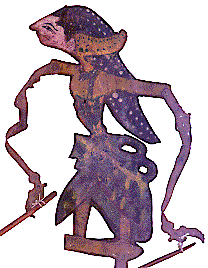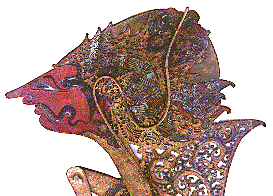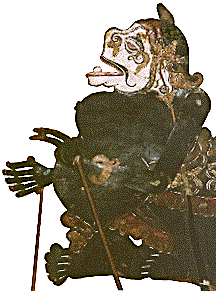Wayang literally means shadow, but refers to all types of puppet theater. Java has three types of puppets.
- Wayang kulit: leather shadow puppets perform Indonesian versions of the Indian Hindu epics.
- Wayang golek: wooden rod puppets perform the Hindu cycles and also an Islamic Arabian adventure cycle.
- Wayang klitik: flat wooden puppets perform the adventures of Javanese Majapahit Empire heros.
- Also wayang beber, an earlier, related form where the storyteller unrolled a scroll of painted scenes.
Other Indonesian puppets:
- Bali: The Balinese use shadow puppets that are more naturalistic in style than the Javanese ones. Baron landong are large comic puppets worn by humans. They are temple puppets and only appear occasionally.
- Lombok: Shadow puppets perform Islamic stories.
- North Sumatra: Large Si Galegale articulated puppets dance as substitute mourners at funerals of childless Toba Batak people.
- Puppet-like figures include Torajan effigies of the dead, Tau-Tau, in Sulawesi and a Javanese child's play that uses a puppet-like manikin, Nini Towong.

[Flat wooden female wayang klitik puppet]
The puppet master, the dalang, manipulates his set of 100 to 500 shadow puppets, or 65 to 70 rod puppets, during a performance that often lasts all night.
Wayang Kulit
Puppets range from 10 to 30 inches high (25 to 75 cm). A basic village set has over 100. There are up to 500 in a palace set. Important characters are represented by several different versions in a set.
[White water buffalo hide of unpainted wayang kulit puppet gives a lacy effect: 42k]
Hide is scraped thin to make it even, then cured so it will not warp. The best puppets are made from young female water buffalo parchment and the curing can take up to ten years. Village puppets use thicker water buffalo or goat hide, sometimes sticks and rice straw or even cardboard or scrap metal.
The puppet maker, using a template as a guide, scratches the outline and guide lines for details into the hide. He cuts the body free plus separate pieces for the arms. The details are punched with a wooden mallet and sets of metal punches and chisels. In a fine puppet, this takes weeks.
Figure 1: Unpainted puppet shows the finely punched detail in her stylized clothes and the graceful curve of the horn handle. She may represent Srikandi, one of the wives of Arjuna. Her dodot skirt train hangs to the side in the Jogjakarta style.
Puppets are fitted with long polished buffalo (kebu) horn or bamboo stick handles. The leather arms are hinged at the shoulders and elbows with metal, bone or bamboo studs, then fitted with sticks for the dalang to move. Expensive puppets made for display even have gold studs set with diamonds.
Better puppets are painted with traditional pigments including powdered burnt bone for white, lampblack, indigo, yellow ochre and cinnabar mixed in fish glue or egg tempera mediums and accented with gold leaf. Cheaper puppets are finished with store paint and gilt. Children often do the painting and the inked details so they will learn the different characters. Some characters are partially identified by their color: Vishnu is black; Siva has a gold face. Red shows a fiery temperament, white represents innocence or youth.
The puppet characters range between alus (extremely refined) and kasar (rough and crude). Refined, virtuous characters have small bodies, slitted oval eyes with pupils like rice grains, pointed noses and a modest downward gaze to delicate feet. More vigorous characters look up.
Middle size characters may be strong like good kings or princely warriors. For example, this puppet of Karno, one of the hundred Kurewas princes opposing the virtuous Pandawa princes.
 Figure 2: (Above) Karno is one of the "bad" princes, but has many characteristics of the princely alus style.
Figure 2: (Above) Karno is one of the "bad" princes, but has many characteristics of the princely alus style.More aggressive characters are physically bigger. Their noses and eyes get larger and rounder. Their teeth may show in a snarl. Some large puppets represent physically strong, but virtuous characters. Characters like ogres have only one arm.
Shadow puppets may have came from India with traders and priests who used them to explain the Hindu religion; however, they could predate Hindu influence as all the terms are Javanese. Puppet theater was established in the royal courts by the 1st century A.D. The first documentary evidence appears in the 11th - 13th centuries.
The highly stylized form of Javanese puppets is usually considered to be Islamic, but a similar style also appears on earlier Hindu carvings at Candi Panataran. Balinese shadow puppets are more naturalistic.
Besides the characters of humans and gods, there are puppets of birds, all kinds of domestic and wild animals like elephants, tigers and horses, even sets of weapons. Some puppets like the Batara Buru, equated with Siva standing on a bull, are powerful and seldom seen. Every set must have one, but it is kept in a special bag to protect it.
 The puppets are always evolving, especially the clowns who sometimes ride motorbikes and smoke. The most important clowns are the Panakawan, who may represent pre-Hindu, Javanese guardian spirits. They do not appear in the Indian versions of the Ramayana or the Mahabharata, but are among the more important characters in the Javanese versions.
The puppets are always evolving, especially the clowns who sometimes ride motorbikes and smoke. The most important clowns are the Panakawan, who may represent pre-Hindu, Javanese guardian spirits. They do not appear in the Indian versions of the Ramayana or the Mahabharata, but are among the more important characters in the Javanese versions.They act as advisors and supporters of the aristocracy in the puppet plays, but they represent the village and also the spirit of the land itself. They are buffoons and jesters, sensual and erotic, yet they are also the voice of common sense. Semar, the leader and most beloved of the Panakawan
Wayang Golek and Wayang Klitik
[2 male rod puppets. One has a fierce, bright red face. The other wears a bright flowered shirt: 24k]
Wayang golek rod puppets are created in family workshops. The master carver makes the head because it expresses the personality of the character. There are ceremonies before carving strong puppets like gods or demons.
The head is roughed out from soft wood with a saw or adz. Then the details are chiseled in. Younger family members do the bodies. The articulated arms are hinged with rattan, string or metal fastenings. The central support rod is attached to the base of the body where it is hidden by the clothing. The women make all the costumes.
Figure 1: Wayang golek puppets, probably from the Menak cycle of adventures of Muhammad's uncle. Their sarongs are wrapped tightly around the rods for storage between performances.
[Black wayang klitik puppet with some white color detail on the sarong and headdress : 10k]
Wayang klitik puppets are flat wooden puppets carved in low relief and painted. They have leather arms like the wayang kulit puppets. They are occasionally used in daytime performances without a screen for plays from the Wayang Gedog cycle. They are also carved for sale using characters from the Hindu epics.
Figure 2: This large wayang klitik puppet is an aggressive character with the kasar trait of a big nose.
Wayang golek and wayang klitik wooden puppets are heavier than leather shadow puppets and more difficult for the dalang to carry, so there are only about 65 to 70 puppets in a set. Puppets play more than one character in these smaller sets, but they must match the type. The dalang's role is the same and the stage is similar, but without the screen.
[2 aristocratic female rod puppets in traditional dress and hairdos: 26k]
If the story is one of the Hindu classics, the wooden puppets follow the stylized characteristics of the shadow puppets. If the stories are from one of the Javanese cycles, the puppets have everyday traditional Javanese form, hair styles and dress with lots of detail and bright colors.
Figure 3: Wayang golek puppets dressed in silk blouses and scarves, cotton batik skirts, necklaces of glass beads, seeds and tassels, metal bracelets and other jewelry set with paste gems. A dealer in Solo had old puppets from a more refined set whose fingers were exquisitely carved in classic Javanese guestures.
Only Java uses wooden puppets, but different areas of the island have different styles. They are believed to have originated on the north coast. Sometimes a wayang golek puppet called a tayub or gambyong, dances at dawn at the end of a wayang kulit performance to remind the viewers to consider the message of play.
Rod puppets are produced for plays, for tourists, and for wealthy Javanese collectors who use them only for display. These collector puppets represent characters that the family identifies with or that were perhaps favorites from childhood.

No comments:
Post a Comment